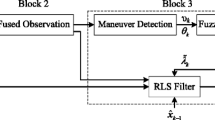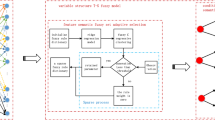Abstract
In this paper, a novel maximum fuzzy correntropy Kalman filter (MFC-KF) algorithm is proposed to solve the problem that the effect of different samples on state estimation is uncertain in common correntropy. In the proposed algorithm, a new optimization criterion—the maximum fuzzy correntropy criterion with fuzzy correntropy based on fuzzy information theory—is used to optimize the Kalman filter, by reducing the effect of the common correntropy applying the same weight for all samples. Moreover, to apply the MFC-KF algorithm to bearings-only maneuvering target tracking, it is combined with the least-squares method for measurement conversion. Moreover, the kernel width is set adaptively. Simulations show that the proposed algorithm can track a target more accurately than the interactive multi-model extended Kalman filter (IMMEKF), the interactive multi-model unscented Kalman filter (IMMUKF), or the maximum correntropy Kalman filter (MCKF).



Similar content being viewed by others
Explore related subjects
Discover the latest articles, news and stories from top researchers in related subjects.References
Li, Z., Wu, H.: A survey of maneuvering target tracking using Kalman filter. In: 4th international conference on mechatronics, materials, chemistry and computer engineering, Atlantis Press (2015)
Blom, H.A.P., Bar-shalom, Y.: The interacting multiple model algorithm for systems with markovian switching coefficients. IEEE Trans. Autom. Control. 33(8), 780–783 (1988)
Gupta, S.D., Yu, J.Y., Mallick, M., Coates, M., Morelande, M.: Comparison of angle-only filtering algorithms in 3D using EKF, UKF, PF, PFF, and Ensemble KF. In: 18th international conference on information fusion Washington, July 6–9, pp. 1649–1656 (2015)
Boudreau, D., Kabal, P.: Joint gradient-based time-delay estimation and adaptive minimum mean-squared-error filtering. Can. J. Electr. Comput. Eng. 18(1), 27–35 (1993)
Jiang, Y., Baoyin, H.: Robust extended Kalman filter with input estimation for maneuver tracking. Chin. J. Aeronaut. 31(9), 1910–1919 (2018)
Yu, J., Chen, L.: From Static to Dynamic Tag Population Estimation: An Extended Kalman Filter Perspective, Tag Counting and Monitoring in Large-Scale RFID Systems, pp. 43–75. Springer, Cham (2019)
Sadeghi, B., Moshiri, B.: Second-order EKF and unscented Kalman filter fusion for tracking maneuvering targets. In: IEEE international conference on information reuse and integration (2007)
Roth, M., Gustafsson, F.: An efficient implementation of the second order extended Kalman filter. In: International conference on information fusion. IEEE (2011)
Gao, B., Hu, G., Gao, S., et al.: Multi-sensor optimal data fusion for INS/GNSS/CNS integration based on unscented Kalman filter. Int. J. Control Autom. Syst. 16(1), 129–140 (2018)
Zhao, Y.: Performance evaluation of cubature Kalman filter in a GPS/IMU tightly-coupled navigation system. Signal Process. 119, 67–79 (2016)
Zhang, A., Bao, S., Gao, F., et al.: A novel strong tracking cubature Kalman filter and its application in maneuvering target tracking. Chin. J. Aeronaut. 32(11), 2489–2502 (2019)
Taghavi, E., Tharmarasa, R., Kirubarajan, T., et al.: Multisensor-multitarget bearing-only sensor registration[J]. IEEE Trans. Aerosp. Electron. Syst. 52(4), 1654–1666 (2016)
Liang-qun, Li, Wei-xin, Xie, Zong-xiang, Liu: Auxiliary truncated particle filtering with least-square method for bearings-only maneuvering target tracking. IEEE Trans. Aerosp. Electron. Syst. 52(5), 2564–2569 (2016)
Nguyen, N.H., Doanay, K.: Improved pseudolinear Kalman Filter algorithms for bearings-only target tracking. IEEE Trans. Signal Process. 65(23), 6119–6134 (2017)
Xie, Y., Song, T.L.: Bearings-only multi-target tracking using an improved labeled multi-Bernoulli filter. Signal Process 151, 32–44 (2018)
Erdogmus, D., Principe, J.C.: Generalized information potential criterion for adaptive system training. IEEE Trans. Neural Networks 13(5), 1035–1044 (2002)
Singh, A., Príncipe, J.C.: Using correntropy as a cost function in linear adaptive filters. In: International joint conference on neural networks, IJCNN 2009, Atlanta, Georgia, USA, 14–19 June 2009. IEEE (2009)
Chen, B., Zhu, P., Principe, J.C.: Survival information potential: a new criterion for adaptive system training. IEEE Trans. Signal Process. 60(3), 1184–1194 (2012)
Principe, J.C.: Information Theoretic Learning: Renyi’s Entropy and Kernel Perspectives. Springer Science & Business Media, Berlin (2010)
Wu, Z., Peng, S., Chen, B., et al.: Robust Hammerstein adaptive filtering under maximum correntropy criterion. Entropy 17(10), 7149–7166 (2015)
Chen, B., Xing, L., Liang, J., et al.: Steady-state mean-square error analysis for adaptive filtering under the maximum correntropy criterion. IEEE Signal Process. Lett. 21(7), 880–884 (2014)
Chen, B., Xing, L., Zhao, H., et al.: Generalized correntropy for robust adaptive filtering. IEEE Trans. Signal Process. 64(13), 3376–3387 (2016)
Chen, B., Liu, X., Zhao, H., et al.: Maximum correntropy Kalman filter. Automatica 76, 70–77 (2017)
Liu, W., Pokharel, P.P., Principe, J.C.: Correntropy: properties and applications in non-Gaussian signal processing. IEEE Trans. Signal Process. 55(11), 5286–5298 (2007)
Li, L.Q., Wang, X.L., Xie, W.X., et al.: A novel recursive TS fuzzy semantic modeling approach for discrete state-space systems. Neurocomputing 340, 222–232 (2019)
Agarwal, R.P., Meehan, M., O’Regan, D.: Fixed point theory and applications. Cambridge University Press, Cambridge (2001)
Chen, B., Wang, J., Zhao, H., et al.: Convergence of a fixed-point algorithm under maximum correntropy criterion. IEEE Signal Process. Lett. 22(10), 1723–1727 (2015)
Zhang, T., Liu, C., Cai, Y.: Maneuvering target tracking algorithm based on multi-station bearing-only passive location with incomplete observation. In: Chinese Control Conference (2014) (in Chinese)
Wang, W., Zhao, J., Qu, H., et al.: A switch kernel width method of correntropy for channel estimation. In: 2015 International Joint Conference on Neural Networks, IEEE (2015)
Acknowledgements
This work was supported by the National Natural Science Foundation of China (Grant No. 61773267), Science & Technology Program of Shenzhen (Grant No. JCYJ20170302145519524, JCYJ20190808120417257), Shanxi Science and Technology Department Projects (201801D221047).
Author information
Authors and Affiliations
Corresponding author
Appendix
Appendix
Equation (24) is derived as follows:
From Eqs. (A.1) and (A.2), we have
From the inverse formula of a matrix, \((A - BD^{ - 1} C)^{ - 1} = A^{ - 1} + A^{ - 1} B(D - CA^{ - 1} B)^{ - 1} CA^{ - 1}\), we get
From Eqs. (A.1)–(A.3), we have
Equation (24) can be obtained from Eqs. (23), (A.5), and (A.6).
Rights and permissions
About this article
Cite this article
Li, LQ., Sun, Yc. & Liu, ZX. Maximum Fuzzy Correntropy Kalman Filter and Its Application to Bearings-Only Maneuvering Target Tracking. Int. J. Fuzzy Syst. 23, 405–418 (2021). https://doi.org/10.1007/s40815-020-00956-0
Received:
Revised:
Accepted:
Published:
Issue Date:
DOI: https://doi.org/10.1007/s40815-020-00956-0




